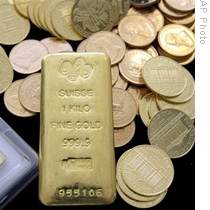New Delhi
19 September 2009
 |
| Gold coins and bars (file) |
India's main festival and wedding season starts in less than two weeks. It is the time of the year when Abhinav Malhotra usually saw his big jewelry shop in South Delhi packed with customers.
But, this year, there is barely a trickle of buyers for the glittering gold bangles, necklaces and earrings on display.
Malhotra says the number of customers is down by half, compared to last year, as surging gold prices and the global economic recession scare away people.
"It has impacted us, big time," he said. "In recession, when you expect prices of other items to come down like automobiles and electronics and many other things, gold is the only commodity where prices are going up like anything."
As gold prices top $1,000 an ounce - the highest price for the metal in the last 18 months - traders say they expect demand to dip drastically this festival and wedding season.
The World Gold Council says, in the first half of the year, India's gold imports slumped by 26 percent, dropping to their lowest level in six years. India is the world's biggest buyer of the precious metal.
The country's passion for gold is rooted in culture and custom. Gold ornaments are a traditional wedding present to brides and a gift of the precious metal during Hindu religious festivals augurs good fortune. It is a traditional gift on other auspicious occasions, such as the birth of a child.
But shop owners say now they only see "essential customers" - those who have to buy for the marriage of a son or a daughter. Even these buyers are scaling back on purchases. Some are passing on traditional heirlooms, instead of buying new gold. Others are cutting back on the quantity of gold they buy and opting for ornaments of lesser weight.
Usha Raina, whose daughter is getting married next month, says she nervously tracks the price of gold, everyday.
"I have to cut down ... It is an Indian wedding, so you cannot do without gold, so I have to give," she said. "But yes, the amount will definitely get reduced."
Gold is getting hit not just by the surging prices. In the big cities, the traditional affinity to the precious metal is waning, as trends change. The new status symbol of the country's affluent class is no longer jewelry, but expensive mobile phones, Ipods or designer labels.
The managing director of the World Gold Council in India, Ajay Mitra, says there is a move away from spending on gold in big cities, such as Mumbai and Delhi. He says rural India and smaller towns are becoming the mainstay of demand for gold in India.
"Close to 60 percent of our gold consumption happens in rural areas. And a large part of it is because I think the rural areas are still culturally closer to the core of our society, and the fabric," he said. "So they continue to practice rituals and norms that they have inherited whereas there is a bit of move away in the urban areas."
But this year, large parts of rural India have been hit by drought, reducing incomes and raising food prices. As a result, Mitra does not see gold demand picking up significantly in the next six months.
"It [gold demand] will continue to be soft, given the fact the rate at which there is price increase," he said. "And we all understand that there are fixed household budgets and also given the fact that generally prices of essential food commodities have taken a major increase."
However, in a country where the love of gold dates back centuries, jewelry shop owners say they will wait patiently for sales to pick up. As has happened many times in the past, they are hoping that customers will flock back, once they get accustomed to the higher prices.